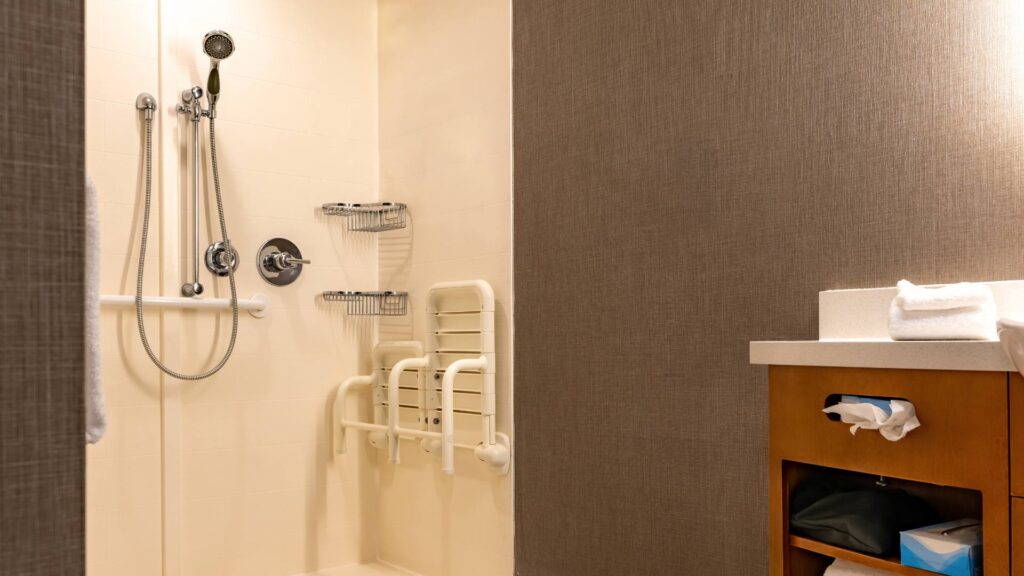ADA bathroom remodeling is a critical aspect of ensuring accessibility, safety, and comfort for individuals with mobility impairments or disabilities. However, several misconceptions about ADA bathroom remodeling often deter people from making these necessary modifications. In this post, Handi-Bath Remodeling will debunk some of the most common myths surrounding ADA bathroom remodeling, shedding light on the realities and benefits of creating an accessible bathroom.
Misconception 1: ADA-Compliant Bathrooms Are Unattractive
One of the most pervasive myths is that ADA-compliant bathrooms are unattractive and institutional-looking. Many people envision sterile, hospital-like environments when they think of accessibility features. However, modern ADA bathroom designs can be both functional and aesthetically pleasing. With the right planning and materials, you can create a stylish bathroom that seamlessly integrates accessibility features.
Today’s market offers a wide range of attractive fixtures, such as sleek grab bars, contemporary roll-in showers, and stylishly designed toilets and sinks. These elements can be incorporated into any bathroom design without sacrificing style. The key is to work with experienced designers and contractors who understand how to blend functionality with beauty.
Misconception 2: ADA Remodeling is Expensive
Another common misconception is that ADA bathroom remodeling is prohibitively expensive. While it’s true that there can be additional costs associated with accessibility modifications, many affordable solutions can make a significant difference. Furthermore, the long-term benefits of an ADA-compliant bathroom often outweigh the initial investment.
For instance, installing grab bars, a hand-held showerhead, or a higher toilet can be relatively inexpensive yet greatly enhance safety and usability. Additionally, there are various grants and financial assistance programs available to help cover the costs of accessibility modifications. By working with a knowledgeable remodeling company like Handi-Bath Remodeling, you can find cost-effective solutions tailored to your budget.
Misconception 3: ADA Bathrooms Are Only for Wheelchair Users
Many people believe that ADA bathrooms are only necessary for wheelchair users. While wheelchair accessibility is a crucial aspect of ADA compliance, these modifications benefit a broader range of individuals. ADA-compliant bathrooms are designed to be accessible to anyone with mobility challenges, including the elderly, those with temporary injuries, and people with other disabilities.
Features like walk-in tubs, non-slip flooring, and adjustable showerheads can enhance safety and comfort for various users. By creating a bathroom that accommodates diverse needs, you can ensure that everyone in your household or business has access to a safe and functional space.
Misconception 4: ADA Remodeling Decreases Home Value
Some homeowners worry that making their bathroom ADA-compliant will negatively impact their property’s value. However, the opposite is often true. As the population ages, there is a growing demand for homes with accessibility features. An ADA-compliant bathroom can make your home more appealing to a broader range of buyers, including those looking for homes where they can age in place.
Moreover, a well-designed ADA bathroom demonstrates a commitment to inclusivity and forward-thinking, which can enhance your home’s marketability. By investing in accessibility modifications, you’re not only meeting immediate needs but also future-proofing your property.
Misconception 5: ADA Standards Are Inflexible
Another myth is that ADA standards are rigid and leave no room for customization. In reality, ADA guidelines provide a framework for accessibility but allow for a degree of flexibility in how they are implemented. This means that you can tailor your bathroom remodel to fit your specific needs and preferences while still adhering to ADA principles.
For example, while ADA guidelines specify certain dimensions and clearances, there are multiple ways to achieve these requirements. You can choose from a variety of materials, colors, and styles to create a bathroom that reflects your personal taste. Working with an experienced contractor can help you navigate these guidelines and find creative solutions that meet both your accessibility and design goals.
Misconception 6: ADA Remodeling is Only for Large Bathrooms
Some people believe that ADA-compliant bathrooms require a lot of space and are only feasible in large bathrooms. However, ADA features can be incorporated into bathrooms of all sizes. With thoughtful design and planning, even small bathrooms can be made accessible.
Space-saving solutions, such as corner sinks, compact toilets, and sliding doors, can help maximize the usability of a small bathroom. Additionally, open-concept designs and the strategic placement of fixtures can create a more spacious and accessible environment. A professional remodeler can help you identify the best options for making your bathroom ADA-compliant, regardless of its size.
Conclusion
ADA bathroom remodeling is essential for creating safe, functional, and inclusive spaces for individuals with disabilities or mobility challenges. By debunking these common misconceptions, we hope to encourage more people to consider the benefits of ADA-compliant bathrooms. At Handi-Bath Remodeling, we specialize in designing and installing beautiful, accessible bathrooms tailored to your unique needs. Whether you’re looking to enhance safety, improve usability, or increase your home’s value, our team at Handi-Bath is here to help you achieve your goals with a thoughtful and stylish approach to ADA bathroom remodeling.


